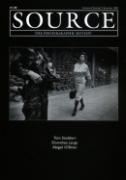Satellite
'Satellite' by Paddy Jolley was at the Gallery of Photography, Dublin, 1996
Review by Aidan Dunne
Issue 8 Summer 1996
View Contents ▸
The film historian Eric Rhode, writing some years ago about Andrez Wajda's film 'Ashes and Diamonds', suggested that at key moments in the narrative, the director contrived to undermine the viewer's habitual sense of superiority. He did so, as Rhode saw it, by plunging us into the middle of the action, leaving us unsure and disorientated, even literally unbalanced. Michael J. Arlen, writing about television news coverage of the Vietnam war in the 1960's , said that a crucial turning point in reporting the war came when a renowned reporter found himself caught up in an action and appeared on air visibly alarmed, breathless and unsure of what was going on. What was significant, Arlen noted, was not the chaos of battle, because everyone knew that people were being killed all the time, but the fact that such an imperturbable authority figure was out of breath. From 'Satellite' by Paddy Jolley
From 'Satellite' by Paddy Jolley
Paddy Jolley, in 'Satellite' as for that matter in his previous work, certainly tries to jolt us out of any comfortable familiarity we might feel as spectators at an exhibition. Image after image sets out to involve us in situations that have the quality of fragmentary narratives and to deny us any sense of controlling perspective. With each new image we lurch, like Mulder and Scully, into oblique contact with something disturbing and unfamiliar. We don't have enough information to categorise what we see.
In effect the apparatus of documentary photography is used to wrench us into contact with these unexpected situations, on which we are in no position to pass judgment: the jarring aftermath of an accident, the eruption of a violent row, visual incongruities which may or may not call for intervention. We are left uncertain. Perhaps that's just the way things are, perhaps something is wrong. But he is determined to offer us no help: if there is a framing narrative that will render things in any particular image comprehensible, he keeps it to himself.
Yet the pictures come to us from a familiar world. In a press release accompanying the show, the rationale is perhaps over-elaborated. The title 'Satellite' refers to the ring-roads that encircle major European cities. Jolley explores the strange, intermediate spaces that emerge because of the logistics of organising big cities, the spaces in which mere humans seem superfluous.
There is the infrastructure of transport, the motorways, flyovers, underpasses, car parks, the masses of railway lines, useful but horrendously inimical to actual human presence. One of the best photographs is a neutral account of a complex mass of high rises and railway lines in which is implicit a rhetorical question: Is this the kind of world we've made? Then there are the gaps, the scrubland of unused spaces, fenced off empty sites, awkward communal areas in flat complexes, the strange, anomalous spaces the arise when buildings meets and overlap with lanes, waterways, roads.
An ominous role is reserved for people in this dystopian megalopolis. There is the man rolling across the underpass, who may have been side swiped by two retreating cars; the body garbed in dressing gown and pyjamas, face down in a mirror-calm sheet of water; two blurred figures scuffling furiously on a rooftop; a young woman sitting on a bed, her expression neutral, in a room that has an anonymous, generic look about it; two male figures in their underpants, with bags over their heads, in a derelict room scattered with debris; a couple and a child before a small terraced house; two figures embracing tightly, emerging from the earth and swathed in a prophylactic sheet of polythene.
For the most part Jolley composes his pictures brilliantly. He likes to up the ante with a few characteristic tropes: things flying through the air in a giddy blur, sheets of incandescent flame, careful colour tinting and manipulation. In fact the best, most memorable images are ones that come closest to documentary verisimilitude, where everything is just about ordinary but very strange indeed. Like the massive industrial structure, damaged and listing to one side, tat is like a big, wounded animal. Or the opened garage strewn with unrolled towelling. Or the jumble of moulded plastic and metal chairs tipped on the landscaped space beside blocks of flats. It's all there - there's no need to elaborate.






